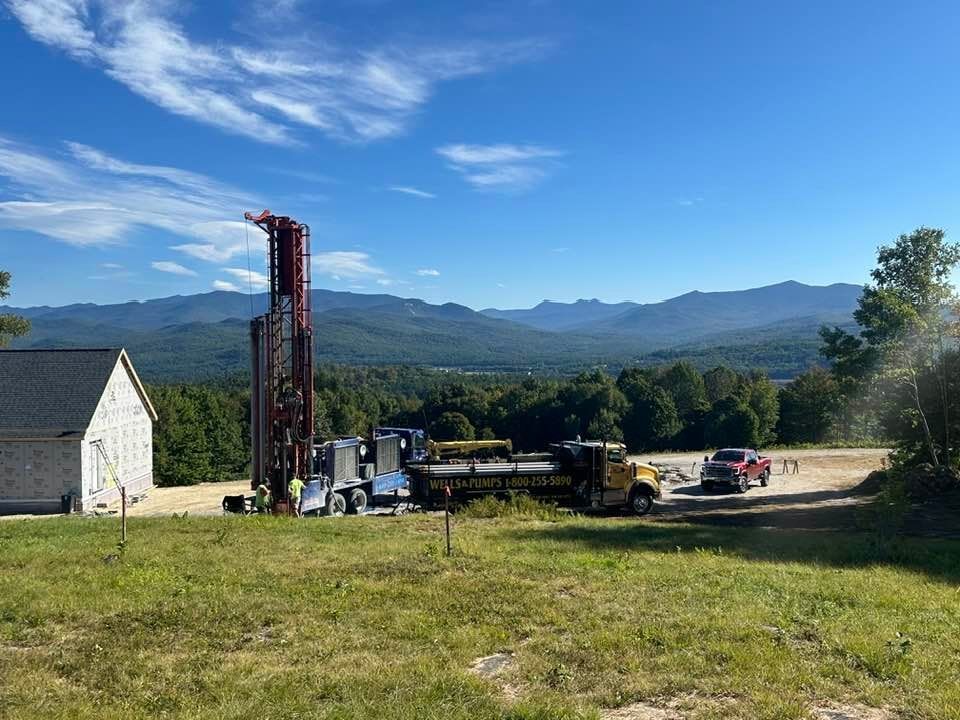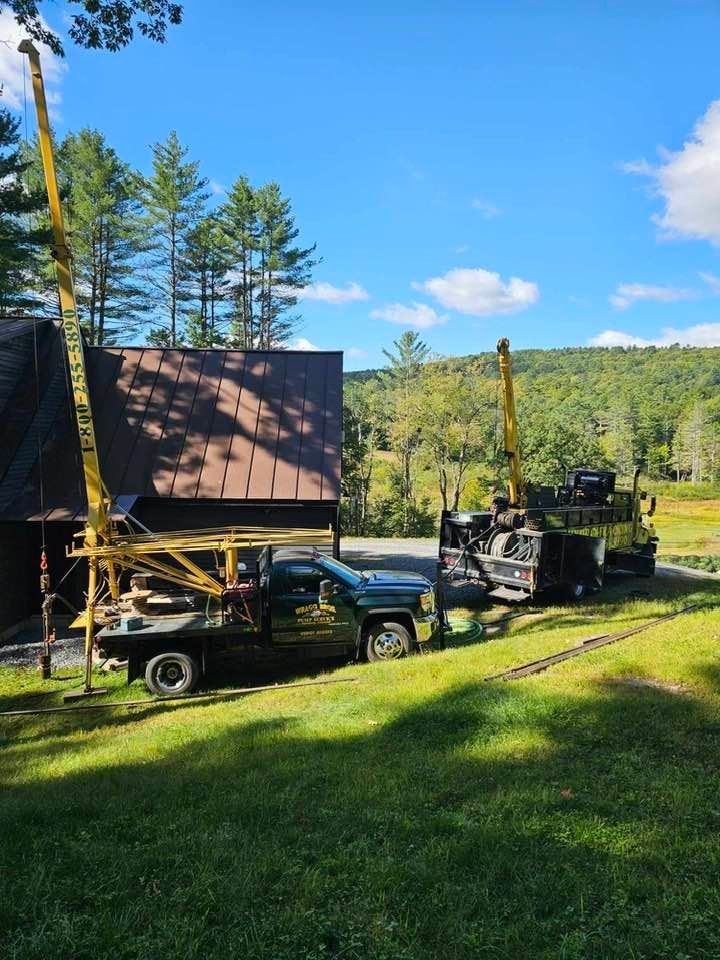Water treatment, water testing, well drilling and hydro-fracking services for VT, NH, and MA.
Do you need emergency well water service?
Discover the Merits of Geothermal Energy
Geothermal energy stands out for its low carbon emissions, minimal land use, and consistent power supply. In this article, we’ll explore these merits of geothermal energy and more, covering everything from environmental benefits to economic considerations.
Key Takeaways
- Geothermal energy is a sustainable and renewable resource that provides a low carbon footprint and minimal land use, making it environmentally friendly compared to fossil fuels.
- Key advantages of geothermal energy include high reliability and stability for baseload energy demand, as well as versatile applications such as heating and cooling systems.
- Despite high upfront costs and location dependency, advancements in technology and job creation in the geothermal sector enhance its economic viability and growth potential.

Understanding Geothermal Energy
Geothermal energy is a marvel of nature, derived from the Earth’s internal heat. This energy originates from massive pools of heat beneath the earth’s surface, primarily generated by the decay of radioactive materials within the Earth’s core. The Earth’s inner core reaches a staggering temperature of approximately 10,800°F, creating a continuous and immense source of heat energy. This heat is harnessed through geothermal reservoirs, which consist of pockets of heated water and rock, often found along tectonic plate boundaries.
Geothermal energy is classified as a clean and renewable energy source, characterized by its sustainability and environmental friendliness. Natural geothermal sites, such as hot springs, geysers, thermal pools, and active volcanoes, serve as visible manifestations of this subterranean heat.
Utilizing geothermal resources allows for electricity generation and heating solutions without the significant environmental impact of fossil fuels, making geothermal energy a vital component of the renewable energy landscape.

Environmental Benefits of Geothermal Energy
Harnessing geothermal energy offers numerous environmental benefits that make it a standout choice among renewable energy sources. The Earth continuously produces it, ensuring a sustainable supply. Unlike fossil fuels, geothermal energy does not cause significant pollution, contributing to a cleaner environment.
Additionally, geothermal energy requires much less land compared to solar and wind energy facilities, making it a more discreet and less intrusive option.
Low Carbon Footprint
One of geothermal energy's most compelling advantages is its low carbon footprint. Compared to fossil fuels like coal and natural gas, geothermal energy produces significantly fewer carbon emissions. Reducing carbon output helps mitigate global warming and promotes a healthier planet.
As we strive to reduce greenhouse gas emissions, geothermal energy stands out as an effective and sustainable solution.
Small Land Use
Another noteworthy benefit of geothermal energy is its minimal land use. Compared to solar and wind energy facilities, geothermal power plants require much less land area. For example, a solar farm requires about 2,340 square miles more land than a geothermal power plant to produce the same amount of energy.
Similarly, geothermal plants have a smaller footprint compared to wind power installations, making them a more space-efficient option.
Sustainable and Renewable
Geothermal energy is inherently sustainable and renewable, thanks to the Earth’s natural processes that continuously replenish its heat. The constant heat from geothermal sources ensures long-term energy availability without the risk of depletion.
This sustainability makes geothermal energy a reliable long-term solution for our energy needs, contributing to a more stable and resilient energy infrastructure.

Reliability and Stability
Geothermal energy offers unmatched reliability and stability, which is essential for maintaining grid stability. Geothermal power plants provide a constant and dependable power supply suitable for baseload energy demand. With capacity factors often exceeding 80% and, in some cases, reaching over 96%, geothermal plants demonstrate significant reliability compared to other energy sources.
High consistency in power output reinforces grid stability and ensures continuous energy supply for residential and industrial applications.
Versatile Applications of Geothermal Energy
The versatility of geothermal energy extends far beyond electricity generation. From heating buildings to providing cooling solutions, geothermal energy can be adapted for various applications. The geothermal energy sector is rapidly evolving, with cutting-edge technologies enhancing its efficiency and expanding its potential applications.
Geothermal energy is a flexible and multifaceted resource, whether it’s used in geothermal power plants, heating and cooling systems, or district heating networks.
Geothermal Power Plants
Geothermal power plants are the backbone of geothermal energy production. These plants typically consist of two wells: a production well and an injection well, which facilitate the extraction and reinjection of geothermal fluids. By tapping into the Earth’s heat to operate steam turbines, geothermal power plants efficiently generate electricity.
There are various types of geothermal power plants, including dry steam, flash steam, and binary plants, each employing different methods to produce electricity. Recent advancements in Enhanced Geothermal Systems (EGS) and drilling techniques have further expanded access to geothermal resources, making these plants more effective and economically viable.
Heating and Cooling Solutions
Geothermal heat pump systems offer a highly efficient solution for heating and cooling buildings. These systems leverage the stable underground temperatures to provide consistent heat and cool year-round. Consuming significantly less electricity than traditional systems, heat pump geothermal heat pumps can reduce heating utility bills by 55-75%.
Ground-source heat pumps (GSHPs) utilize these underground temperatures, maintaining a consistent 55 degrees Fahrenheit at depths as shallow as 20 feet. Geothermal systems have impressive lifespans: heat pumps last around 20 years, and underground infrastructure can last up to 50 years.
Companies like Wragg Brothers Well Drilling specialize in installing these systems, providing sustainable energy solutions for both new and existing buildings.
District Heating Systems
District heating systems provide an efficient way to distribute geothermal heat to multiple buildings through a network of pipes. This setup is less complex than geothermal power plants, as it doesn’t require deep drilling.
District heating systems using geothermal energy provide cost-effective and efficient heating, ensuring warmth in entire communities and reducing overall energy consumption and costs.
Economic Considerations
When it comes to economic considerations, geothermal energy presents both opportunities and challenges. While the initial investment costs can be high, the long-term savings on energy expenses and the potential for job creation make it an attractive option. With proper maintenance, geothermal facilities can remain operational for 30 to 50 years, ensuring a long-term energy supply.
This energy source is increasingly recognized for its diverse applications across residential, industrial, and agricultural sectors. Although geothermal projects often face high initial costs, they can lead to significant savings over time.
Long-Term Cost Savings
Despite the substantial upfront costs, geothermal energy projects can offer significant long-term cost savings. Homeowners typically recover the initial investment within 5-10 years through reduced utility bills. The stable energy prices and reduced operational costs contribute to overall financial benefits, making geothermal installations a wise investment.
However, utility-scale solar and wind energy projects generally have lower capital costs, making geothermal energy a more expensive option initially.
Job Creation
The geothermal industry’s significant growth is translating into job opportunities across various sectors. From drilling and engineering to plant maintenance, the expanding industry is contributing to job creation. This growth not only supports the economy but also helps build a skilled workforce dedicated to advancing renewable energy technologies.

Technological Advancements in Geothermal Energy
The geothermal energy sector is rapidly evolving, with new technologies and projects driving its expansion. As the Energy Geothermal Technologies Office has highlighted, innovations in drilling techniques and Enhanced Geothermal Systems (EGS) have significantly improved the efficiency and feasibility of geothermal energy extraction.
These advancements are making geothermal energy a more accessible and cost-effective option for a wider range of applications.
Enhanced Geothermal Systems (EGS)
Enhanced Geothermal Systems (EGS) represent a significant advancement in geothermal energy technology. By fracturing rock with high-speed water to create flow channels for steam, an enhanced geothermal system improves energy extraction from geothermal sources. This technology allows geothermal energy to be harnessed in areas previously considered unviable due to geological constraints, broadening the scope of geothermal projects.
The growth of the geothermal sector is also projected to create thousands of jobs in engineering, drilling, and plant maintenance.
Innovations in Drilling Techniques
Advanced drilling technologies are crucial for reducing costs and improving the overall efficiency of geothermal energy extraction. Innovations in drilling methods have expanded access to deeper geothermal resources, making the process faster and more cost-effective.
These advancements are instrumental in the scalability and economic viability of geothermal projects, ensuring that geothermal energy can compete with other renewable energy technologies.
Challenges Facing Geothermal Energy
Despite its many benefits, geothermal energy faces several challenges. Key issues include high upfront costs, location dependency, and potential environmental concerns.
Effective resource management prevents the depletion of geothermal reservoirs and ensures the long-term viability of geothermal energy projects.
High Upfront Costs
High upfront costs significantly hinder the widespread adoption of geothermal energy. The expenses are mainly due to the difficulty and cost of drilling deep into the Earth. Construction costs for geothermal energy plants typically range from $4,000 to $6,000 per kilowatt, with installation costs for a 1-megawatt plant between $2.5 million and $5 million.
Exploration and drilling expenses often account for half of geothermal project costs.
Location Dependency
Geothermal energy generation is constrained by its location dependency. Geothermal energy can only be harnessed in areas with existing hydrothermal resources, which are often limited to specific geographic locations. Wragg Brothers emphasizes the importance of geological assessment to determine the most effective geothermal system for a given location.
In the United States, suitable geothermal sites are primarily located in the western regions.
Environmental Concerns
Environmental concerns also challenge geothermal energy. Geothermal power plants can potentially induce seismic events, particularly if Enhanced Geothermal Systems (EGS) are employed. For instance, a geothermal project in Switzerland triggered an earthquake with a magnitude of 3.4.
Additionally, geothermal power plants can cause land subsidence and generate small amounts of greenhouse gases such as sulfur dioxide and silica, although the pollution is minimal compared to coal and fossil fuels.

Wragg Brothers Well Drilling Expertise
With over 65 years of experience, Wragg Brothers Well Drilling has established itself as a leader in well drilling services. The company offers a variety of services, including well drilling, hydrofracking, water conditioning, and water treatment, making them a valuable partner in geothermal projects.
Using specialized drilling equipment and techniques, Wragg Brothers can access geothermal reservoirs deep within the Earth’s crust, contributing significantly to the success of geothermal energy projects. Their expertise and extensive experience ensure that geothermal wells are drilled efficiently and effectively, providing a reliable source of sustainable energy.
Summary
Geothermal energy stands out as a powerful and sustainable solution in the quest for renewable energy. Its low carbon footprint, minimal land use, and continuous supply make it an environmentally friendly choice. The reliability and stability of geothermal power, coupled with its versatile applications in power generation, heating, and cooling, highlight its potential to meet diverse energy needs. Economic considerations, including long-term cost savings and job creation, further underscore the value of investing in geothermal energy.
While challenges such as high upfront costs and location dependency exist, technological advancements and expertise from companies like Wragg Brothers Well Drilling are paving the way for wider adoption. By harnessing the Earth’s natural heat, we can achieve a cleaner, more sustainable energy future. As we continue to innovate and address these challenges, geothermal energy promises to play a crucial role in our transition to renewable energy sources. Embrace the power of geothermal energy and explore its potential to transform our energy landscape.
Frequently Asked Questions
What are the positive economic impacts of geothermal energy?
Geothermal energy positively impacts the economy by stimulating job creation through expenditures on services and equipment and increasing tax revenues. This contribution fosters overall economic activity in the region.
What are the merits and demerits of geothermal energy?
Geothermal energy offers significant advantages such as a low carbon footprint and reliable, continuous energy supply. However, its demerits include high initial costs and potential environmental concerns associated with land and water use.
What services does Wragg Brothers Well Drilling provide?
Wragg Brothers Well Drilling offers a comprehensive range of services, including well drilling, hydrofracking, water conditioning, water treatment, and water testing. This ensures all aspects of water sourcing and quality are effectively addressed.
How many years of experience does Wragg Brothers Well Drilling have?
Wragg Brothers Well Drilling has over 65 years of experience in well drilling, demonstrating their longstanding expertise in the field.
What is the service area of Wragg Brothers Well Drilling?
Wragg Brothers Well Drilling services customers across New Hampshire, Vermont, and Massachusetts.
All Rights Reserved | Wragg Brothers Well Drilling


